More than just play: Developing cognitive and physical skills in early childhood education - Desklib
VerifiedAdded on 2023/05/28
|16
|3268
|440
AI Summary
This article discusses the importance of developing cognitive and physical skills in early childhood education. It covers the domains of learning, learning resources, lesson plans, and more. The article emphasizes the need to provide appropriate resources as per the child's age and developmental ability and to focus on the child's interests. The article also provides examples of lesson plans and teaching strategies.
Contribute Materials
Your contribution can guide someone’s learning journey. Share your
documents today.

Running head: BACHELOR IN EARLY YEARS
BACHELOR IN EARLY YEARS
Name of the Student
Name of the university
Author’s note
BACHELOR IN EARLY YEARS
Name of the Student
Name of the university
Author’s note
Secure Best Marks with AI Grader
Need help grading? Try our AI Grader for instant feedback on your assignments.
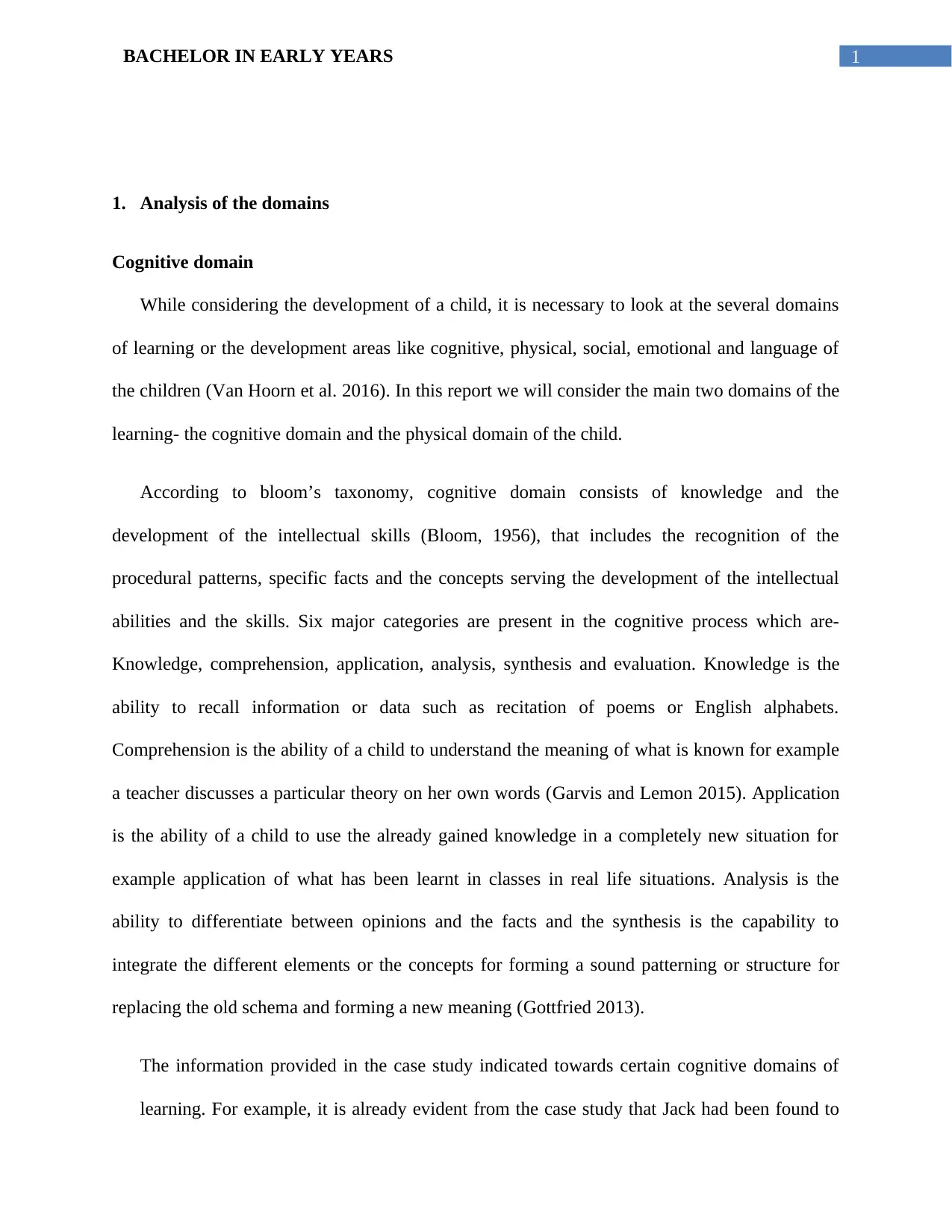
1BACHELOR IN EARLY YEARS
1. Analysis of the domains
Cognitive domain
While considering the development of a child, it is necessary to look at the several domains
of learning or the development areas like cognitive, physical, social, emotional and language of
the children (Van Hoorn et al. 2016). In this report we will consider the main two domains of the
learning- the cognitive domain and the physical domain of the child.
According to bloom’s taxonomy, cognitive domain consists of knowledge and the
development of the intellectual skills (Bloom, 1956), that includes the recognition of the
procedural patterns, specific facts and the concepts serving the development of the intellectual
abilities and the skills. Six major categories are present in the cognitive process which are-
Knowledge, comprehension, application, analysis, synthesis and evaluation. Knowledge is the
ability to recall information or data such as recitation of poems or English alphabets.
Comprehension is the ability of a child to understand the meaning of what is known for example
a teacher discusses a particular theory on her own words (Garvis and Lemon 2015). Application
is the ability of a child to use the already gained knowledge in a completely new situation for
example application of what has been learnt in classes in real life situations. Analysis is the
ability to differentiate between opinions and the facts and the synthesis is the capability to
integrate the different elements or the concepts for forming a sound patterning or structure for
replacing the old schema and forming a new meaning (Gottfried 2013).
The information provided in the case study indicated towards certain cognitive domains of
learning. For example, it is already evident from the case study that Jack had been found to
1. Analysis of the domains
Cognitive domain
While considering the development of a child, it is necessary to look at the several domains
of learning or the development areas like cognitive, physical, social, emotional and language of
the children (Van Hoorn et al. 2016). In this report we will consider the main two domains of the
learning- the cognitive domain and the physical domain of the child.
According to bloom’s taxonomy, cognitive domain consists of knowledge and the
development of the intellectual skills (Bloom, 1956), that includes the recognition of the
procedural patterns, specific facts and the concepts serving the development of the intellectual
abilities and the skills. Six major categories are present in the cognitive process which are-
Knowledge, comprehension, application, analysis, synthesis and evaluation. Knowledge is the
ability to recall information or data such as recitation of poems or English alphabets.
Comprehension is the ability of a child to understand the meaning of what is known for example
a teacher discusses a particular theory on her own words (Garvis and Lemon 2015). Application
is the ability of a child to use the already gained knowledge in a completely new situation for
example application of what has been learnt in classes in real life situations. Analysis is the
ability to differentiate between opinions and the facts and the synthesis is the capability to
integrate the different elements or the concepts for forming a sound patterning or structure for
replacing the old schema and forming a new meaning (Gottfried 2013).
The information provided in the case study indicated towards certain cognitive domains of
learning. For example, it is already evident from the case study that Jack had been found to

2BACHELOR IN EARLY YEARS
be inclined towards music where he had expressed interest while banging on the musical
interest and it can be seen that Jack has shown cognitive learning by resembling the same
patterns of the drum sounds, as her educators makes, which can be related to one of the six
categories of the cognitive domains of the Bloom’s taxonomy that is remembering of the
previous learned information. Enjoying to simple songs and the stories, observing and
imitating the action of the adults are some of the cognitive developmental milestones of
children of this age.
Physical domain
The physical or the psychomotor domain involves physical movement, coordination and the
use of the areas of the motor skills. Development of these kinds of skills needs practice and
can be measured in turns of the distance, speed, precession, flexibility, strength, endurance or
the execution of actions. The psychomotor skills consists of manual tasks like washing of a
car, dancing (Moore 2017). It is evident from the scenario that Jack had expressed interests in
dancing as Jack himself picked up the musical instruments that were provided and started
shaking them and dancing without the assistance of the observer. It can also be seen that
Caitlin, another child also picked up some musical instrument and started to give company to
Jack by shaking her legs to the beat. This action can be related to the category “readiness to
act” which involves both physical, mental and the emotional sets that predetermines the
response of a person to respond to different situations (Moore 2017). Furthermore, this is the
age to learn the complex skills such as dancing and playing of the music instruments. Jack
had been found to be jumping up and down wiggling his hips and shaking his hands with joy.
Such actions are the measurements of the psychomotor learning. Imitation is also considered
to be an important taxonomy of the psychomotor domain, which can be observed in this case
be inclined towards music where he had expressed interest while banging on the musical
interest and it can be seen that Jack has shown cognitive learning by resembling the same
patterns of the drum sounds, as her educators makes, which can be related to one of the six
categories of the cognitive domains of the Bloom’s taxonomy that is remembering of the
previous learned information. Enjoying to simple songs and the stories, observing and
imitating the action of the adults are some of the cognitive developmental milestones of
children of this age.
Physical domain
The physical or the psychomotor domain involves physical movement, coordination and the
use of the areas of the motor skills. Development of these kinds of skills needs practice and
can be measured in turns of the distance, speed, precession, flexibility, strength, endurance or
the execution of actions. The psychomotor skills consists of manual tasks like washing of a
car, dancing (Moore 2017). It is evident from the scenario that Jack had expressed interests in
dancing as Jack himself picked up the musical instruments that were provided and started
shaking them and dancing without the assistance of the observer. It can also be seen that
Caitlin, another child also picked up some musical instrument and started to give company to
Jack by shaking her legs to the beat. This action can be related to the category “readiness to
act” which involves both physical, mental and the emotional sets that predetermines the
response of a person to respond to different situations (Moore 2017). Furthermore, this is the
age to learn the complex skills such as dancing and playing of the music instruments. Jack
had been found to be jumping up and down wiggling his hips and shaking his hands with joy.
Such actions are the measurements of the psychomotor learning. Imitation is also considered
to be an important taxonomy of the psychomotor domain, which can be observed in this case
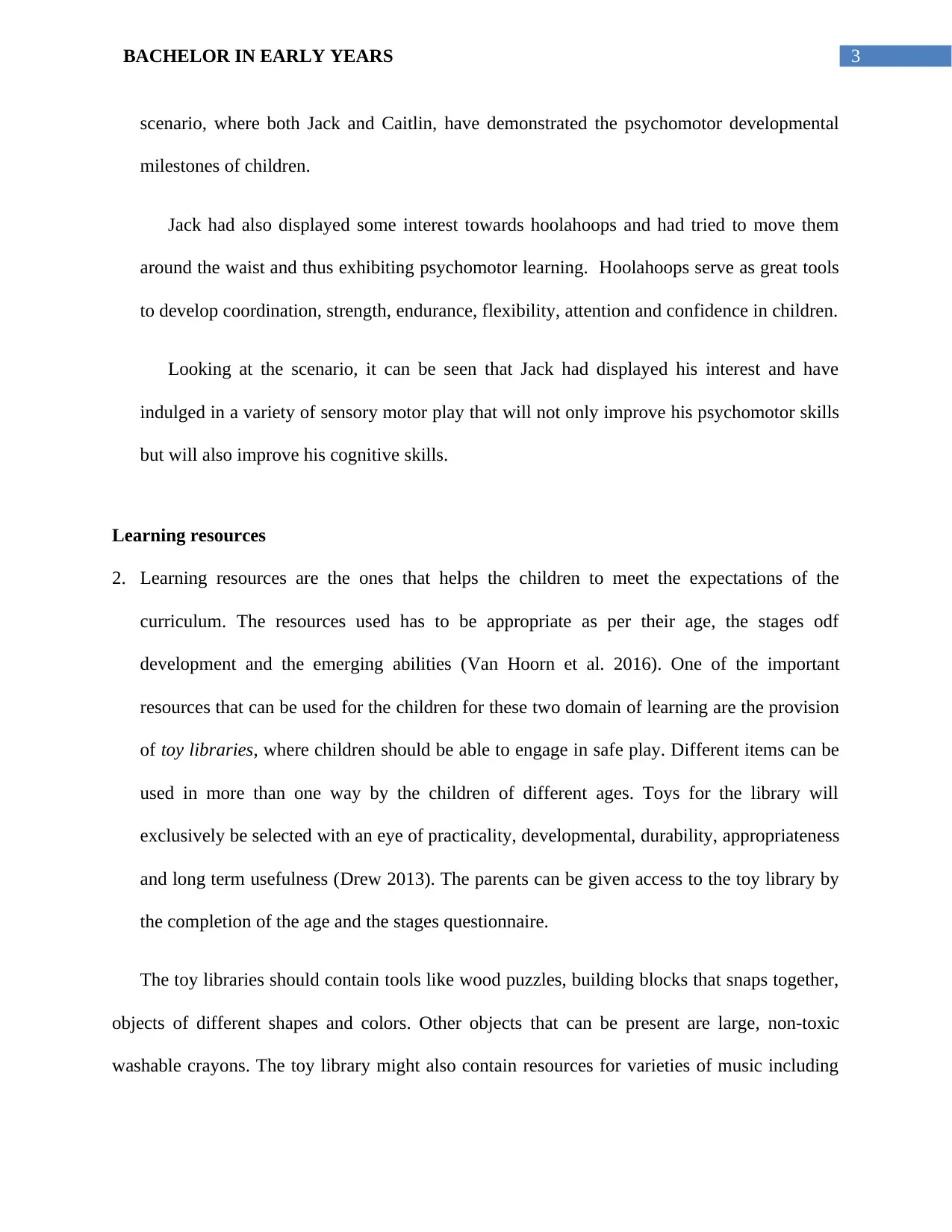
3BACHELOR IN EARLY YEARS
scenario, where both Jack and Caitlin, have demonstrated the psychomotor developmental
milestones of children.
Jack had also displayed some interest towards hoolahoops and had tried to move them
around the waist and thus exhibiting psychomotor learning. Hoolahoops serve as great tools
to develop coordination, strength, endurance, flexibility, attention and confidence in children.
Looking at the scenario, it can be seen that Jack had displayed his interest and have
indulged in a variety of sensory motor play that will not only improve his psychomotor skills
but will also improve his cognitive skills.
Learning resources
2. Learning resources are the ones that helps the children to meet the expectations of the
curriculum. The resources used has to be appropriate as per their age, the stages odf
development and the emerging abilities (Van Hoorn et al. 2016). One of the important
resources that can be used for the children for these two domain of learning are the provision
of toy libraries, where children should be able to engage in safe play. Different items can be
used in more than one way by the children of different ages. Toys for the library will
exclusively be selected with an eye of practicality, developmental, durability, appropriateness
and long term usefulness (Drew 2013). The parents can be given access to the toy library by
the completion of the age and the stages questionnaire.
The toy libraries should contain tools like wood puzzles, building blocks that snaps together,
objects of different shapes and colors. Other objects that can be present are large, non-toxic
washable crayons. The toy library might also contain resources for varieties of music including
scenario, where both Jack and Caitlin, have demonstrated the psychomotor developmental
milestones of children.
Jack had also displayed some interest towards hoolahoops and had tried to move them
around the waist and thus exhibiting psychomotor learning. Hoolahoops serve as great tools
to develop coordination, strength, endurance, flexibility, attention and confidence in children.
Looking at the scenario, it can be seen that Jack had displayed his interest and have
indulged in a variety of sensory motor play that will not only improve his psychomotor skills
but will also improve his cognitive skills.
Learning resources
2. Learning resources are the ones that helps the children to meet the expectations of the
curriculum. The resources used has to be appropriate as per their age, the stages odf
development and the emerging abilities (Van Hoorn et al. 2016). One of the important
resources that can be used for the children for these two domain of learning are the provision
of toy libraries, where children should be able to engage in safe play. Different items can be
used in more than one way by the children of different ages. Toys for the library will
exclusively be selected with an eye of practicality, developmental, durability, appropriateness
and long term usefulness (Drew 2013). The parents can be given access to the toy library by
the completion of the age and the stages questionnaire.
The toy libraries should contain tools like wood puzzles, building blocks that snaps together,
objects of different shapes and colors. Other objects that can be present are large, non-toxic
washable crayons. The toy library might also contain resources for varieties of music including
Secure Best Marks with AI Grader
Need help grading? Try our AI Grader for instant feedback on your assignments.
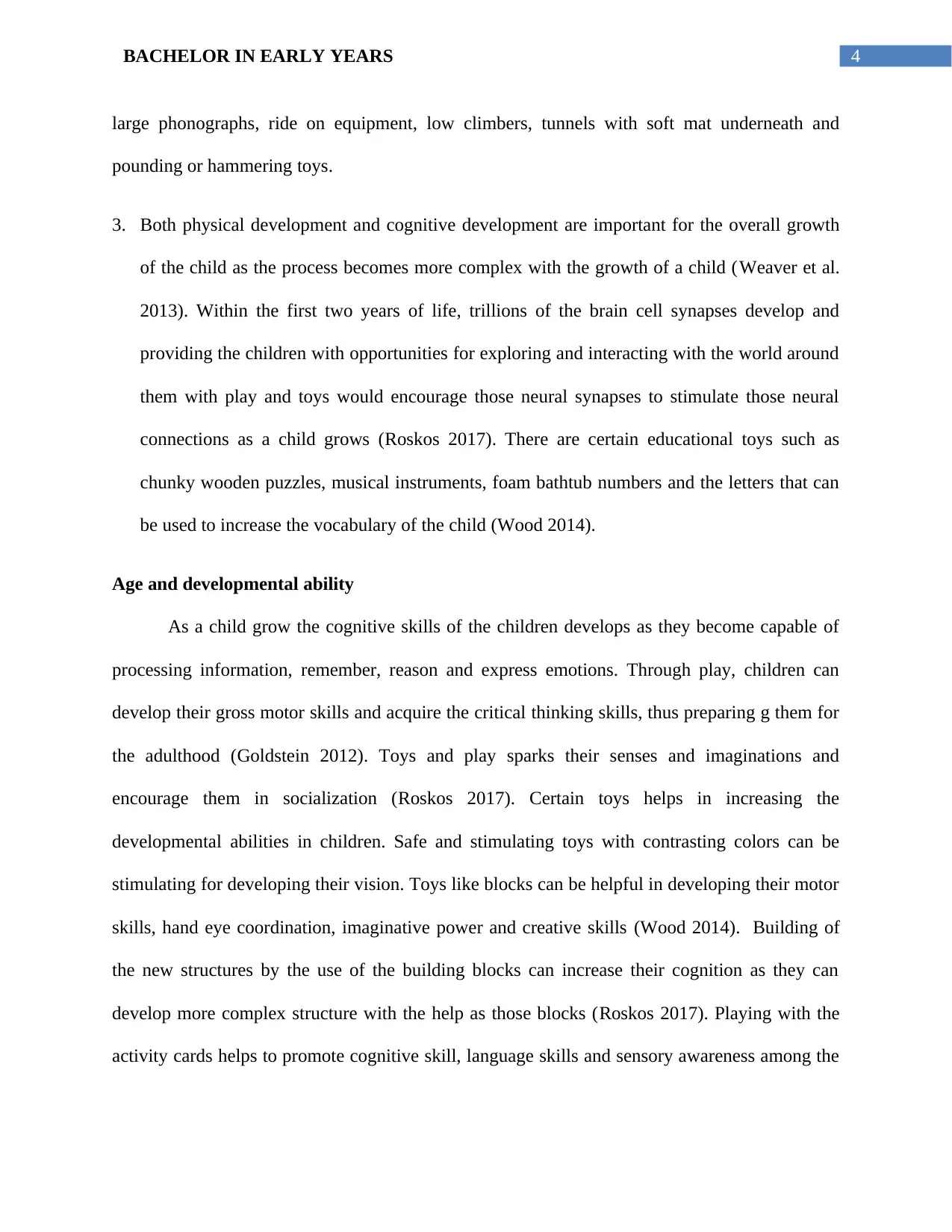
4BACHELOR IN EARLY YEARS
large phonographs, ride on equipment, low climbers, tunnels with soft mat underneath and
pounding or hammering toys.
3. Both physical development and cognitive development are important for the overall growth
of the child as the process becomes more complex with the growth of a child (Weaver et al.
2013). Within the first two years of life, trillions of the brain cell synapses develop and
providing the children with opportunities for exploring and interacting with the world around
them with play and toys would encourage those neural synapses to stimulate those neural
connections as a child grows (Roskos 2017). There are certain educational toys such as
chunky wooden puzzles, musical instruments, foam bathtub numbers and the letters that can
be used to increase the vocabulary of the child (Wood 2014).
Age and developmental ability
As a child grow the cognitive skills of the children develops as they become capable of
processing information, remember, reason and express emotions. Through play, children can
develop their gross motor skills and acquire the critical thinking skills, thus preparing g them for
the adulthood (Goldstein 2012). Toys and play sparks their senses and imaginations and
encourage them in socialization (Roskos 2017). Certain toys helps in increasing the
developmental abilities in children. Safe and stimulating toys with contrasting colors can be
stimulating for developing their vision. Toys like blocks can be helpful in developing their motor
skills, hand eye coordination, imaginative power and creative skills (Wood 2014). Building of
the new structures by the use of the building blocks can increase their cognition as they can
develop more complex structure with the help as those blocks (Roskos 2017). Playing with the
activity cards helps to promote cognitive skill, language skills and sensory awareness among the
large phonographs, ride on equipment, low climbers, tunnels with soft mat underneath and
pounding or hammering toys.
3. Both physical development and cognitive development are important for the overall growth
of the child as the process becomes more complex with the growth of a child (Weaver et al.
2013). Within the first two years of life, trillions of the brain cell synapses develop and
providing the children with opportunities for exploring and interacting with the world around
them with play and toys would encourage those neural synapses to stimulate those neural
connections as a child grows (Roskos 2017). There are certain educational toys such as
chunky wooden puzzles, musical instruments, foam bathtub numbers and the letters that can
be used to increase the vocabulary of the child (Wood 2014).
Age and developmental ability
As a child grow the cognitive skills of the children develops as they become capable of
processing information, remember, reason and express emotions. Through play, children can
develop their gross motor skills and acquire the critical thinking skills, thus preparing g them for
the adulthood (Goldstein 2012). Toys and play sparks their senses and imaginations and
encourage them in socialization (Roskos 2017). Certain toys helps in increasing the
developmental abilities in children. Safe and stimulating toys with contrasting colors can be
stimulating for developing their vision. Toys like blocks can be helpful in developing their motor
skills, hand eye coordination, imaginative power and creative skills (Wood 2014). Building of
the new structures by the use of the building blocks can increase their cognition as they can
develop more complex structure with the help as those blocks (Roskos 2017). Playing with the
activity cards helps to promote cognitive skill, language skills and sensory awareness among the
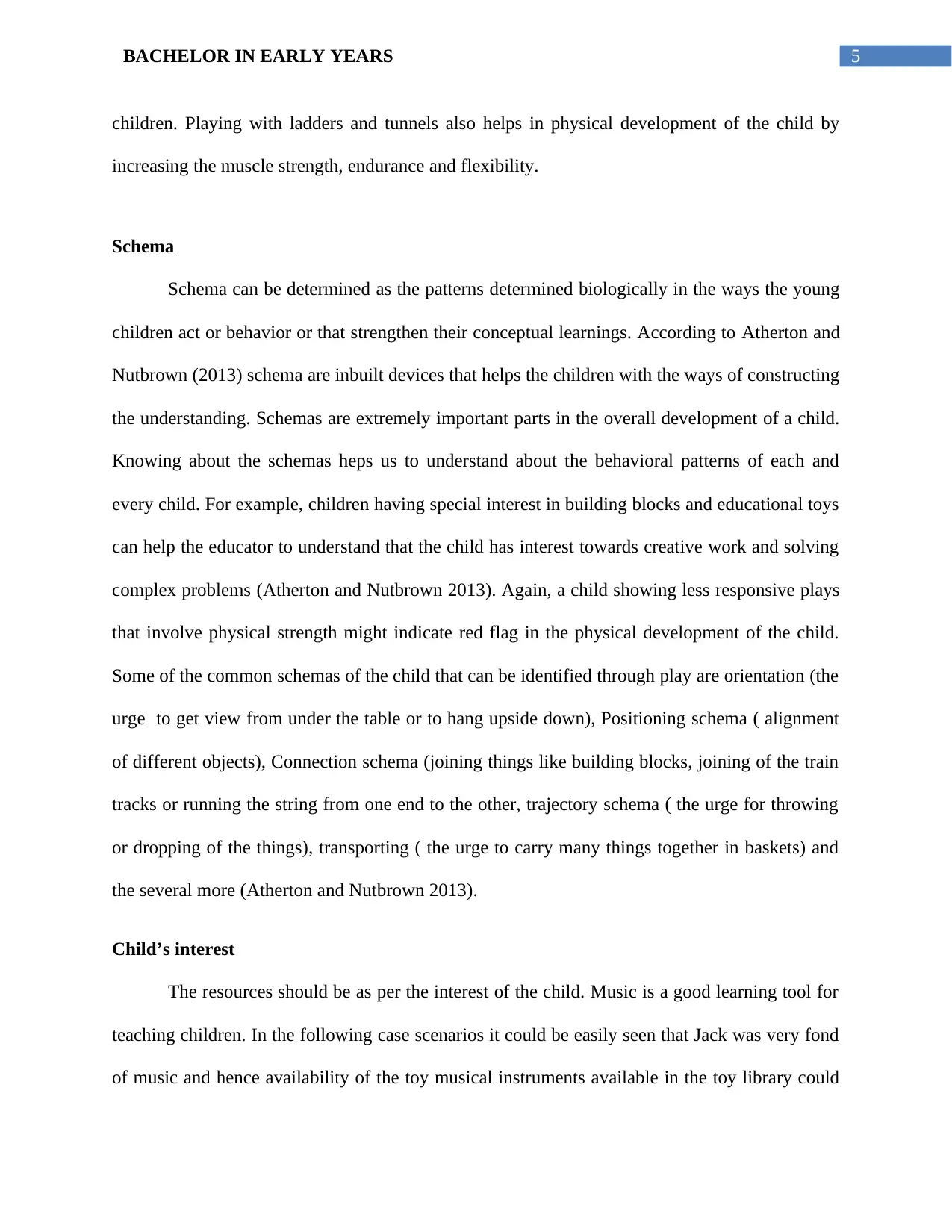
5BACHELOR IN EARLY YEARS
children. Playing with ladders and tunnels also helps in physical development of the child by
increasing the muscle strength, endurance and flexibility.
Schema
Schema can be determined as the patterns determined biologically in the ways the young
children act or behavior or that strengthen their conceptual learnings. According to Atherton and
Nutbrown (2013) schema are inbuilt devices that helps the children with the ways of constructing
the understanding. Schemas are extremely important parts in the overall development of a child.
Knowing about the schemas heps us to understand about the behavioral patterns of each and
every child. For example, children having special interest in building blocks and educational toys
can help the educator to understand that the child has interest towards creative work and solving
complex problems (Atherton and Nutbrown 2013). Again, a child showing less responsive plays
that involve physical strength might indicate red flag in the physical development of the child.
Some of the common schemas of the child that can be identified through play are orientation (the
urge to get view from under the table or to hang upside down), Positioning schema ( alignment
of different objects), Connection schema (joining things like building blocks, joining of the train
tracks or running the string from one end to the other, trajectory schema ( the urge for throwing
or dropping of the things), transporting ( the urge to carry many things together in baskets) and
the several more (Atherton and Nutbrown 2013).
Child’s interest
The resources should be as per the interest of the child. Music is a good learning tool for
teaching children. In the following case scenarios it could be easily seen that Jack was very fond
of music and hence availability of the toy musical instruments available in the toy library could
children. Playing with ladders and tunnels also helps in physical development of the child by
increasing the muscle strength, endurance and flexibility.
Schema
Schema can be determined as the patterns determined biologically in the ways the young
children act or behavior or that strengthen their conceptual learnings. According to Atherton and
Nutbrown (2013) schema are inbuilt devices that helps the children with the ways of constructing
the understanding. Schemas are extremely important parts in the overall development of a child.
Knowing about the schemas heps us to understand about the behavioral patterns of each and
every child. For example, children having special interest in building blocks and educational toys
can help the educator to understand that the child has interest towards creative work and solving
complex problems (Atherton and Nutbrown 2013). Again, a child showing less responsive plays
that involve physical strength might indicate red flag in the physical development of the child.
Some of the common schemas of the child that can be identified through play are orientation (the
urge to get view from under the table or to hang upside down), Positioning schema ( alignment
of different objects), Connection schema (joining things like building blocks, joining of the train
tracks or running the string from one end to the other, trajectory schema ( the urge for throwing
or dropping of the things), transporting ( the urge to carry many things together in baskets) and
the several more (Atherton and Nutbrown 2013).
Child’s interest
The resources should be as per the interest of the child. Music is a good learning tool for
teaching children. In the following case scenarios it could be easily seen that Jack was very fond
of music and hence availability of the toy musical instruments available in the toy library could
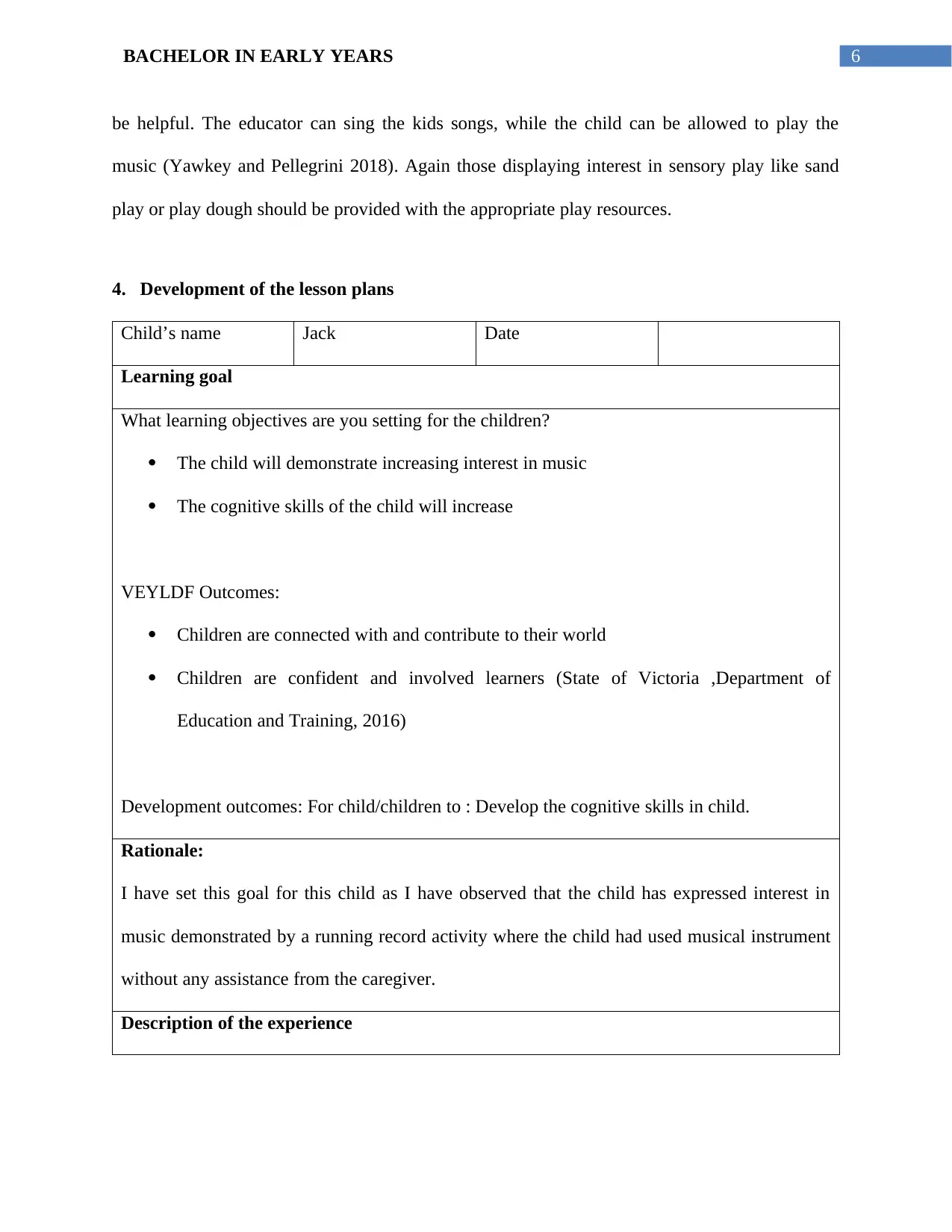
6BACHELOR IN EARLY YEARS
be helpful. The educator can sing the kids songs, while the child can be allowed to play the
music (Yawkey and Pellegrini 2018). Again those displaying interest in sensory play like sand
play or play dough should be provided with the appropriate play resources.
4. Development of the lesson plans
Child’s name Jack Date
Learning goal
What learning objectives are you setting for the children?
The child will demonstrate increasing interest in music
The cognitive skills of the child will increase
VEYLDF Outcomes:
Children are connected with and contribute to their world
Children are confident and involved learners (State of Victoria ,Department of
Education and Training, 2016)
Development outcomes: For child/children to : Develop the cognitive skills in child.
Rationale:
I have set this goal for this child as I have observed that the child has expressed interest in
music demonstrated by a running record activity where the child had used musical instrument
without any assistance from the caregiver.
Description of the experience
be helpful. The educator can sing the kids songs, while the child can be allowed to play the
music (Yawkey and Pellegrini 2018). Again those displaying interest in sensory play like sand
play or play dough should be provided with the appropriate play resources.
4. Development of the lesson plans
Child’s name Jack Date
Learning goal
What learning objectives are you setting for the children?
The child will demonstrate increasing interest in music
The cognitive skills of the child will increase
VEYLDF Outcomes:
Children are connected with and contribute to their world
Children are confident and involved learners (State of Victoria ,Department of
Education and Training, 2016)
Development outcomes: For child/children to : Develop the cognitive skills in child.
Rationale:
I have set this goal for this child as I have observed that the child has expressed interest in
music demonstrated by a running record activity where the child had used musical instrument
without any assistance from the caregiver.
Description of the experience
Paraphrase This Document
Need a fresh take? Get an instant paraphrase of this document with our AI Paraphraser
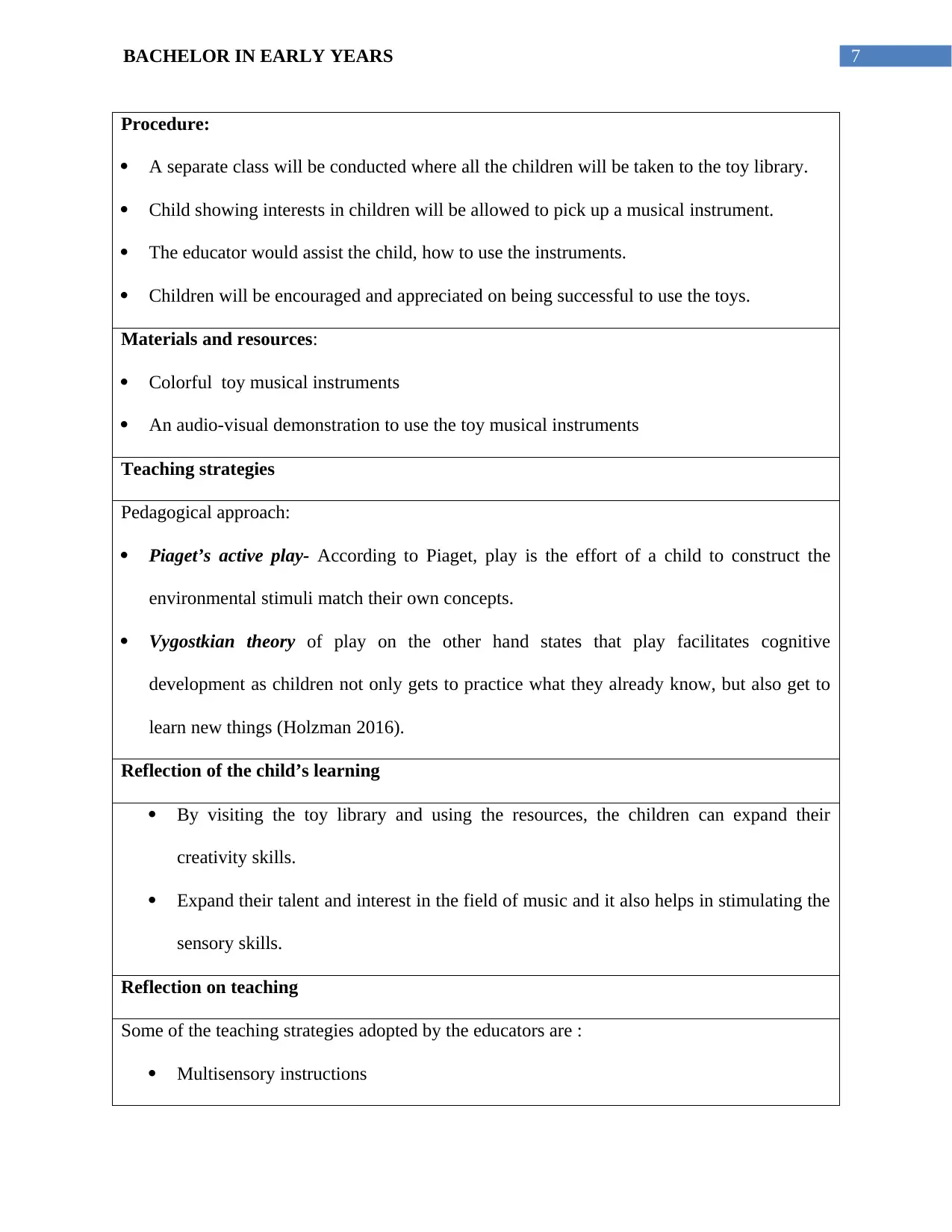
7BACHELOR IN EARLY YEARS
Procedure:
A separate class will be conducted where all the children will be taken to the toy library.
Child showing interests in children will be allowed to pick up a musical instrument.
The educator would assist the child, how to use the instruments.
Children will be encouraged and appreciated on being successful to use the toys.
Materials and resources:
Colorful toy musical instruments
An audio-visual demonstration to use the toy musical instruments
Teaching strategies
Pedagogical approach:
Piaget’s active play- According to Piaget, play is the effort of a child to construct the
environmental stimuli match their own concepts.
Vygostkian theory of play on the other hand states that play facilitates cognitive
development as children not only gets to practice what they already know, but also get to
learn new things (Holzman 2016).
Reflection of the child’s learning
By visiting the toy library and using the resources, the children can expand their
creativity skills.
Expand their talent and interest in the field of music and it also helps in stimulating the
sensory skills.
Reflection on teaching
Some of the teaching strategies adopted by the educators are :
Multisensory instructions
Procedure:
A separate class will be conducted where all the children will be taken to the toy library.
Child showing interests in children will be allowed to pick up a musical instrument.
The educator would assist the child, how to use the instruments.
Children will be encouraged and appreciated on being successful to use the toys.
Materials and resources:
Colorful toy musical instruments
An audio-visual demonstration to use the toy musical instruments
Teaching strategies
Pedagogical approach:
Piaget’s active play- According to Piaget, play is the effort of a child to construct the
environmental stimuli match their own concepts.
Vygostkian theory of play on the other hand states that play facilitates cognitive
development as children not only gets to practice what they already know, but also get to
learn new things (Holzman 2016).
Reflection of the child’s learning
By visiting the toy library and using the resources, the children can expand their
creativity skills.
Expand their talent and interest in the field of music and it also helps in stimulating the
sensory skills.
Reflection on teaching
Some of the teaching strategies adopted by the educators are :
Multisensory instructions
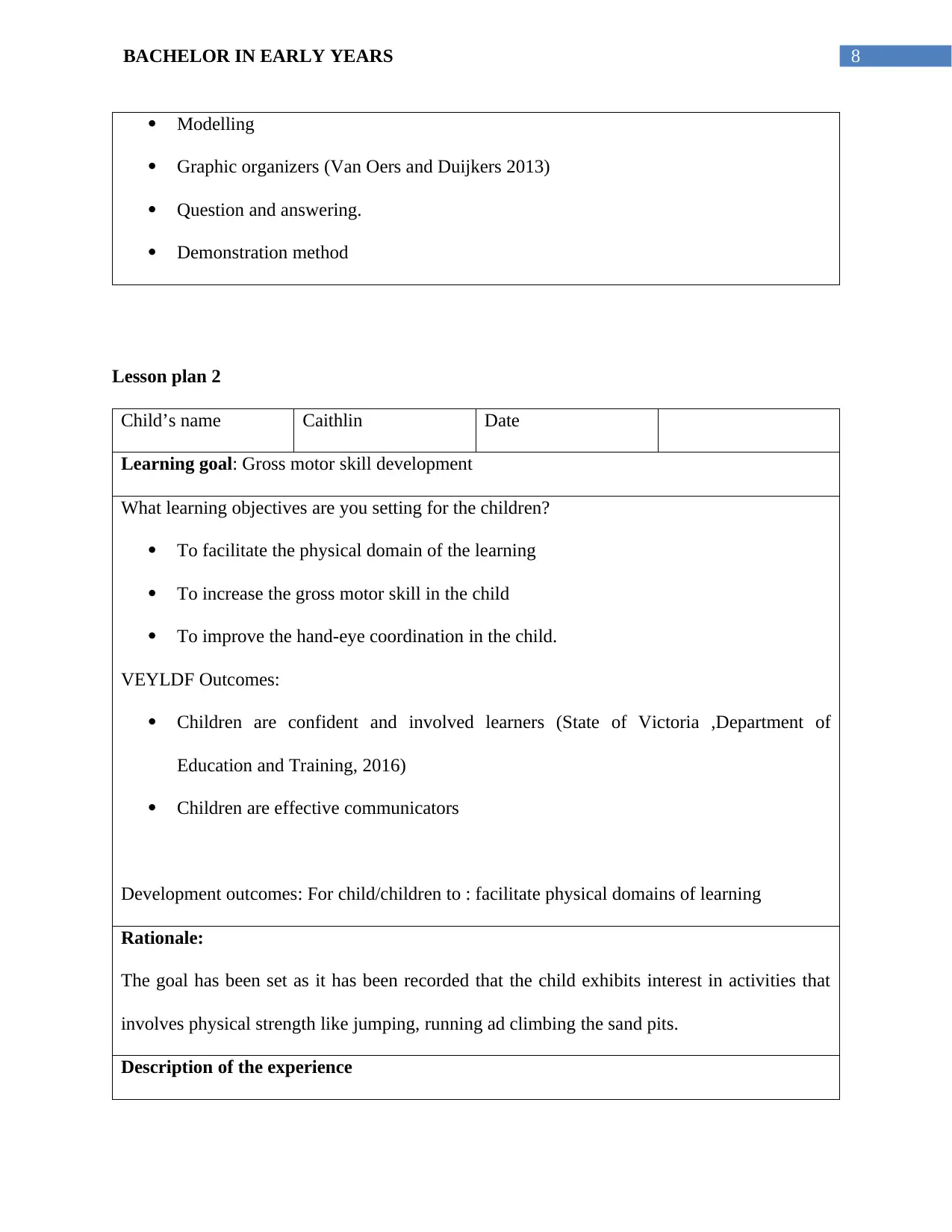
8BACHELOR IN EARLY YEARS
Modelling
Graphic organizers (Van Oers and Duijkers 2013)
Question and answering.
Demonstration method
Lesson plan 2
Child’s name Caithlin Date
Learning goal: Gross motor skill development
What learning objectives are you setting for the children?
To facilitate the physical domain of the learning
To increase the gross motor skill in the child
To improve the hand-eye coordination in the child.
VEYLDF Outcomes:
Children are confident and involved learners (State of Victoria ,Department of
Education and Training, 2016)
Children are effective communicators
Development outcomes: For child/children to : facilitate physical domains of learning
Rationale:
The goal has been set as it has been recorded that the child exhibits interest in activities that
involves physical strength like jumping, running ad climbing the sand pits.
Description of the experience
Modelling
Graphic organizers (Van Oers and Duijkers 2013)
Question and answering.
Demonstration method
Lesson plan 2
Child’s name Caithlin Date
Learning goal: Gross motor skill development
What learning objectives are you setting for the children?
To facilitate the physical domain of the learning
To increase the gross motor skill in the child
To improve the hand-eye coordination in the child.
VEYLDF Outcomes:
Children are confident and involved learners (State of Victoria ,Department of
Education and Training, 2016)
Children are effective communicators
Development outcomes: For child/children to : facilitate physical domains of learning
Rationale:
The goal has been set as it has been recorded that the child exhibits interest in activities that
involves physical strength like jumping, running ad climbing the sand pits.
Description of the experience

9BACHELOR IN EARLY YEARS
Procedure:
Students will be segregated into groups and will be given chance to engage in play.
The session will take place for 45 minutes.
The educator will demonstrate the play
The children will be accompanied by an educator who will evaluate how the children
are doing.
Materials and resources:
Toys like ladders, tunnels and low climbers
Teaching strategies
Demonstration technique
Use of audiovisual aids for demonstrating the play
Pedagogical approach
As per the Piaget’s theory of play, play is the process of assimilation that a child makes to
make the environment matched to its own concept.
Reflection of the child’s learning
With the completion of the play the child demonstrated an increase in the hand eye
coordination
Developed gross motor skills
Developed inquisitiveness
Reflection on teaching
The different teaching strategies that can be used for the play are:-
Multisensory instructions
Procedure:
Students will be segregated into groups and will be given chance to engage in play.
The session will take place for 45 minutes.
The educator will demonstrate the play
The children will be accompanied by an educator who will evaluate how the children
are doing.
Materials and resources:
Toys like ladders, tunnels and low climbers
Teaching strategies
Demonstration technique
Use of audiovisual aids for demonstrating the play
Pedagogical approach
As per the Piaget’s theory of play, play is the process of assimilation that a child makes to
make the environment matched to its own concept.
Reflection of the child’s learning
With the completion of the play the child demonstrated an increase in the hand eye
coordination
Developed gross motor skills
Developed inquisitiveness
Reflection on teaching
The different teaching strategies that can be used for the play are:-
Multisensory instructions
Secure Best Marks with AI Grader
Need help grading? Try our AI Grader for instant feedback on your assignments.
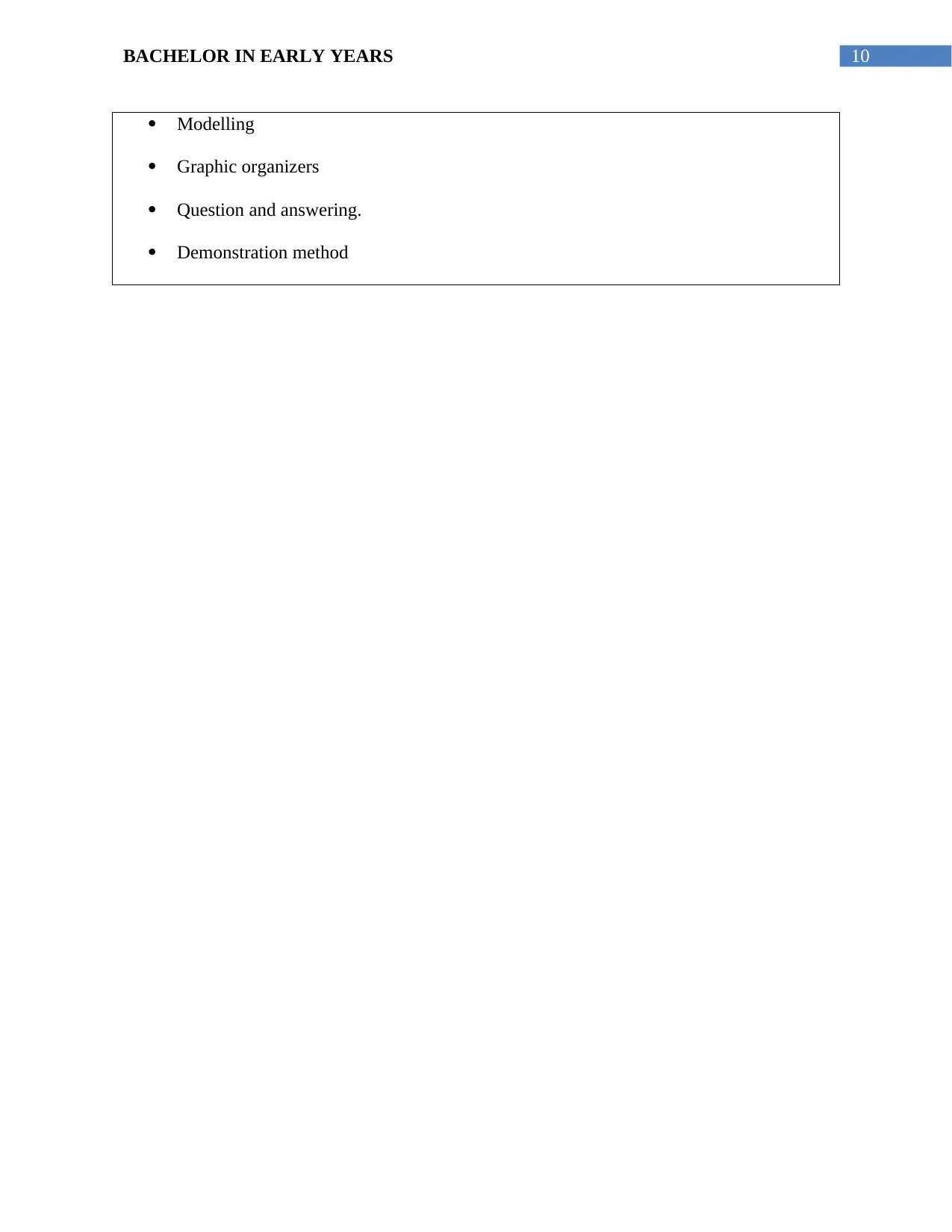
10BACHELOR IN EARLY YEARS
Modelling
Graphic organizers
Question and answering.
Demonstration method
Modelling
Graphic organizers
Question and answering.
Demonstration method
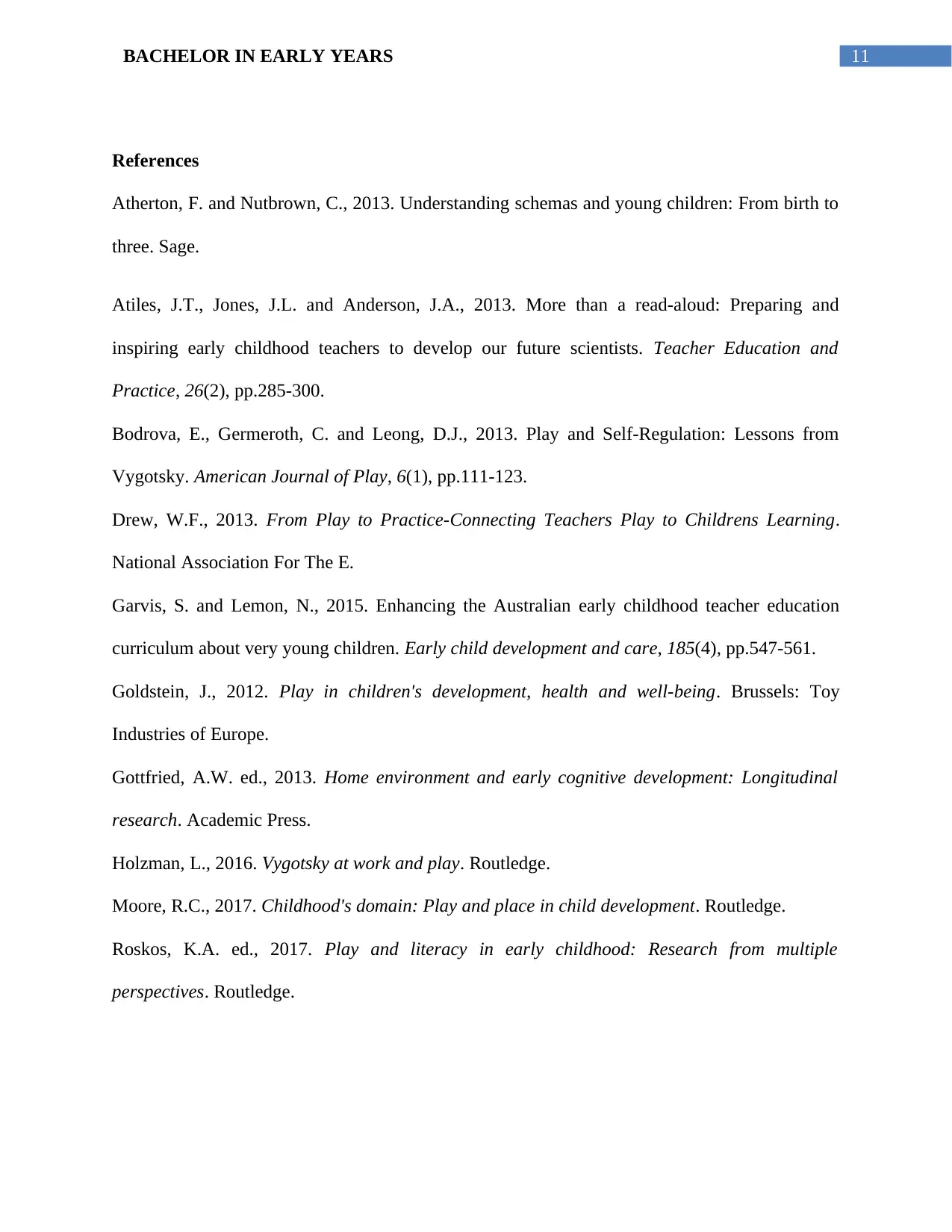
11BACHELOR IN EARLY YEARS
References
Atherton, F. and Nutbrown, C., 2013. Understanding schemas and young children: From birth to
three. Sage.
Atiles, J.T., Jones, J.L. and Anderson, J.A., 2013. More than a read-aloud: Preparing and
inspiring early childhood teachers to develop our future scientists. Teacher Education and
Practice, 26(2), pp.285-300.
Bodrova, E., Germeroth, C. and Leong, D.J., 2013. Play and Self-Regulation: Lessons from
Vygotsky. American Journal of Play, 6(1), pp.111-123.
Drew, W.F., 2013. From Play to Practice-Connecting Teachers Play to Childrens Learning.
National Association For The E.
Garvis, S. and Lemon, N., 2015. Enhancing the Australian early childhood teacher education
curriculum about very young children. Early child development and care, 185(4), pp.547-561.
Goldstein, J., 2012. Play in children's development, health and well-being. Brussels: Toy
Industries of Europe.
Gottfried, A.W. ed., 2013. Home environment and early cognitive development: Longitudinal
research. Academic Press.
Holzman, L., 2016. Vygotsky at work and play. Routledge.
Moore, R.C., 2017. Childhood's domain: Play and place in child development. Routledge.
Roskos, K.A. ed., 2017. Play and literacy in early childhood: Research from multiple
perspectives. Routledge.
References
Atherton, F. and Nutbrown, C., 2013. Understanding schemas and young children: From birth to
three. Sage.
Atiles, J.T., Jones, J.L. and Anderson, J.A., 2013. More than a read-aloud: Preparing and
inspiring early childhood teachers to develop our future scientists. Teacher Education and
Practice, 26(2), pp.285-300.
Bodrova, E., Germeroth, C. and Leong, D.J., 2013. Play and Self-Regulation: Lessons from
Vygotsky. American Journal of Play, 6(1), pp.111-123.
Drew, W.F., 2013. From Play to Practice-Connecting Teachers Play to Childrens Learning.
National Association For The E.
Garvis, S. and Lemon, N., 2015. Enhancing the Australian early childhood teacher education
curriculum about very young children. Early child development and care, 185(4), pp.547-561.
Goldstein, J., 2012. Play in children's development, health and well-being. Brussels: Toy
Industries of Europe.
Gottfried, A.W. ed., 2013. Home environment and early cognitive development: Longitudinal
research. Academic Press.
Holzman, L., 2016. Vygotsky at work and play. Routledge.
Moore, R.C., 2017. Childhood's domain: Play and place in child development. Routledge.
Roskos, K.A. ed., 2017. Play and literacy in early childhood: Research from multiple
perspectives. Routledge.
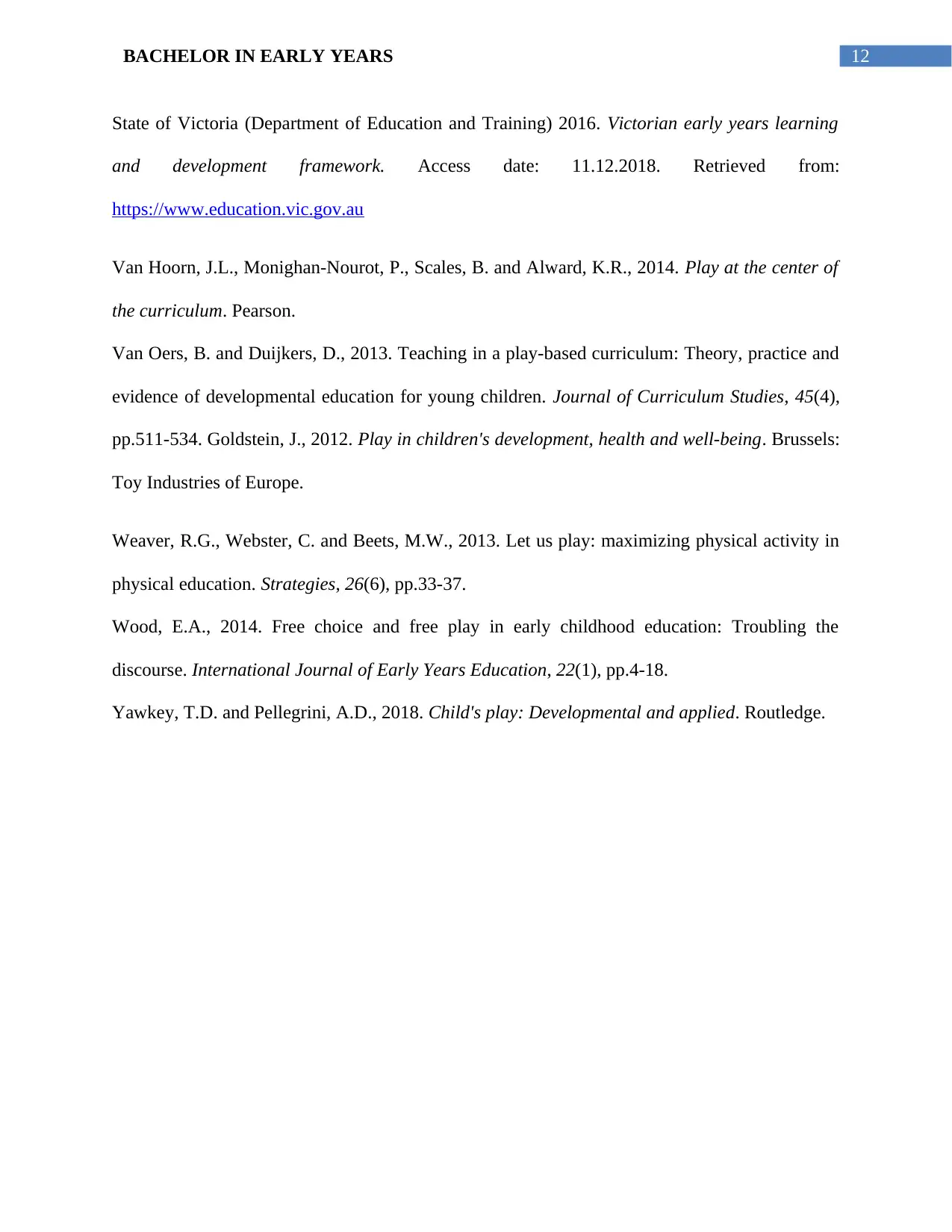
12BACHELOR IN EARLY YEARS
State of Victoria (Department of Education and Training) 2016. Victorian early years learning
and development framework. Access date: 11.12.2018. Retrieved from:
https://www.education.vic.gov.au
Van Hoorn, J.L., Monighan-Nourot, P., Scales, B. and Alward, K.R., 2014. Play at the center of
the curriculum. Pearson.
Van Oers, B. and Duijkers, D., 2013. Teaching in a play-based curriculum: Theory, practice and
evidence of developmental education for young children. Journal of Curriculum Studies, 45(4),
pp.511-534. Goldstein, J., 2012. Play in children's development, health and well-being. Brussels:
Toy Industries of Europe.
Weaver, R.G., Webster, C. and Beets, M.W., 2013. Let us play: maximizing physical activity in
physical education. Strategies, 26(6), pp.33-37.
Wood, E.A., 2014. Free choice and free play in early childhood education: Troubling the
discourse. International Journal of Early Years Education, 22(1), pp.4-18.
Yawkey, T.D. and Pellegrini, A.D., 2018. Child's play: Developmental and applied. Routledge.
State of Victoria (Department of Education and Training) 2016. Victorian early years learning
and development framework. Access date: 11.12.2018. Retrieved from:
https://www.education.vic.gov.au
Van Hoorn, J.L., Monighan-Nourot, P., Scales, B. and Alward, K.R., 2014. Play at the center of
the curriculum. Pearson.
Van Oers, B. and Duijkers, D., 2013. Teaching in a play-based curriculum: Theory, practice and
evidence of developmental education for young children. Journal of Curriculum Studies, 45(4),
pp.511-534. Goldstein, J., 2012. Play in children's development, health and well-being. Brussels:
Toy Industries of Europe.
Weaver, R.G., Webster, C. and Beets, M.W., 2013. Let us play: maximizing physical activity in
physical education. Strategies, 26(6), pp.33-37.
Wood, E.A., 2014. Free choice and free play in early childhood education: Troubling the
discourse. International Journal of Early Years Education, 22(1), pp.4-18.
Yawkey, T.D. and Pellegrini, A.D., 2018. Child's play: Developmental and applied. Routledge.
Paraphrase This Document
Need a fresh take? Get an instant paraphrase of this document with our AI Paraphraser

13BACHELOR IN EARLY YEARS
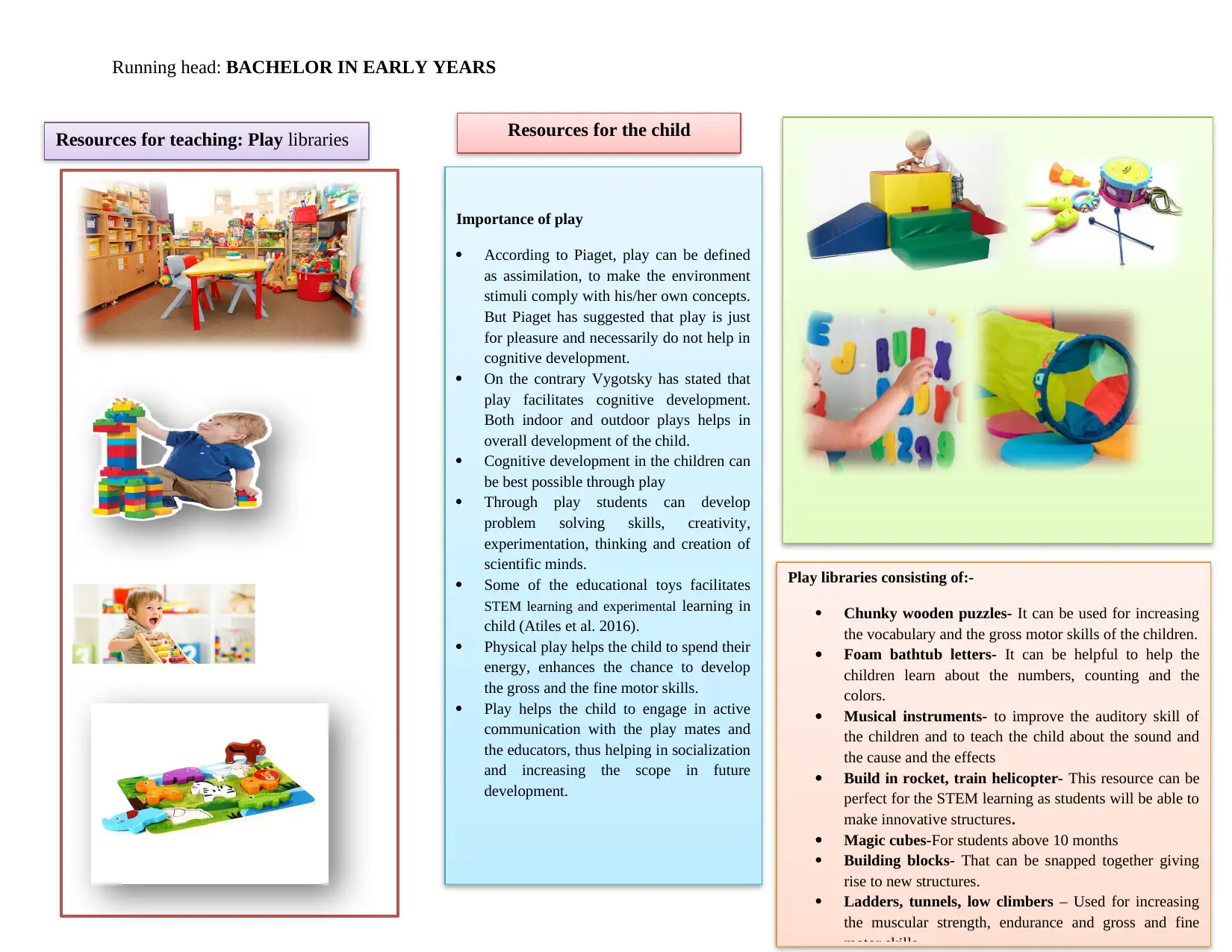
Running head: BACHELOR IN EARLY YEARS
Resources for the child
Resources for teaching: Play libraries
Importance of play
According to Piaget, play can be defined
as assimilation, to make the environment
stimuli comply with his/her own concepts.
But Piaget has suggested that play is just
for pleasure and necessarily do not help in
cognitive development.
On the contrary Vygotsky has stated that
play facilitates cognitive development.
Both indoor and outdoor plays helps in
overall development of the child.
Cognitive development in the children can
be best possible through play
Through play students can develop
problem solving skills, creativity,
experimentation, thinking and creation of
scientific minds.
Some of the educational toys facilitates
STEM learning and experimental learning in
child (Atiles et al. 2016).
Physical play helps the child to spend their
energy, enhances the chance to develop
the gross and the fine motor skills.
Play helps the child to engage in active
communication with the play mates and
the educators, thus helping in socialization
and increasing the scope in future
development.
Play libraries consisting of:-
Chunky wooden puzzles- It can be used for increasing
the vocabulary and the gross motor skills of the children.
Foam bathtub letters- It can be helpful to help the
children learn about the numbers, counting and the
colors.
Musical instruments- to improve the auditory skill of
the children and to teach the child about the sound and
the cause and the effects
Build in rocket, train helicopter- This resource can be
perfect for the STEM learning as students will be able to
make innovative structures.
Magic cubes-For students above 10 months
Building blocks- That can be snapped together giving
rise to new structures.
Ladders, tunnels, low climbers – Used for increasing
the muscular strength, endurance and gross and fine
motor skills.
Resources for the child
Resources for teaching: Play libraries
Importance of play
According to Piaget, play can be defined
as assimilation, to make the environment
stimuli comply with his/her own concepts.
But Piaget has suggested that play is just
for pleasure and necessarily do not help in
cognitive development.
On the contrary Vygotsky has stated that
play facilitates cognitive development.
Both indoor and outdoor plays helps in
overall development of the child.
Cognitive development in the children can
be best possible through play
Through play students can develop
problem solving skills, creativity,
experimentation, thinking and creation of
scientific minds.
Some of the educational toys facilitates
STEM learning and experimental learning in
child (Atiles et al. 2016).
Physical play helps the child to spend their
energy, enhances the chance to develop
the gross and the fine motor skills.
Play helps the child to engage in active
communication with the play mates and
the educators, thus helping in socialization
and increasing the scope in future
development.
Play libraries consisting of:-
Chunky wooden puzzles- It can be used for increasing
the vocabulary and the gross motor skills of the children.
Foam bathtub letters- It can be helpful to help the
children learn about the numbers, counting and the
colors.
Musical instruments- to improve the auditory skill of
the children and to teach the child about the sound and
the cause and the effects
Build in rocket, train helicopter- This resource can be
perfect for the STEM learning as students will be able to
make innovative structures.
Magic cubes-For students above 10 months
Building blocks- That can be snapped together giving
rise to new structures.
Ladders, tunnels, low climbers – Used for increasing
the muscular strength, endurance and gross and fine
motor skills.

Running head: BACHELOR IN EARLY YEARS
1 out of 16
Related Documents
Your All-in-One AI-Powered Toolkit for Academic Success.
+13062052269
info@desklib.com
Available 24*7 on WhatsApp / Email
![[object Object]](/_next/static/media/star-bottom.7253800d.svg)
Unlock your academic potential
© 2024 | Zucol Services PVT LTD | All rights reserved.





